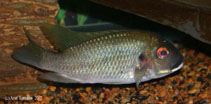| Family: |
Cichlidae (Cichlids), subfamily: Pseudocrenilabrinae |
| Max. size: |
6.7 cm SL (male/unsexed) |
| Environment: |
benthopelagic; freshwater |
| Distribution: |
Africa: endemic to Lake Bemin, Cameroon (Ref. 52307, 81260). |
| Diagnosis: |
Dorsal spines (total): 15-16; Dorsal soft rays (total): 10-11; Anal spines: 3-3; Anal soft rays: 7-8. Diagnosis: lower pharyngeal jaw robust, with a large, heart-shaped dentigerous plate, covered with numerous fine, regularly arrayed teeth; mouth squared and obtuse (Ref. 81260). Lips broad and fleshy; ventral margin of lower lip folded and fringed (Ref. 26738, 81260). Fine buccal dentition of slender, movably implanted, spatulate teeth, 25-45 in outer premaxillary row (Ref. 26738).
Description: moderately deep-bodied species with slightly thickened lips (Ref. 52307). Head length 33.2-36.6% SL; lower pharyngeal jaw with tricuspid anterior teeth and erect bicuspid teeth in posterior row; ventral keel shorter than dentigerous plate; 4-6 tooth rows in upper jaw, outer row teeth bicuspid (Ref. 81260).
Coloration: in life greenish grey dorsally, becoming whitish grey on chest and belly; upper lip dark grey, lower lip brilliant white (Ref. 52307, 81260). Turquoise iridescence on lower lip continuing in band along cheek and base of opercle; dorsal fin yellowish green with yellow lappets; "Tilapia spot" variously developed; caudal, anal, pelvic and pectoral fins dusky grey; faint reddish flecks on opercle and anal fin (Ref. 81260). Some specimens exhibit a bright yellow coloration (at least when spawning) (Ref. 52307). |
| Biology: |
Smaller specimens primarily found between sunken pieces of trees near lake shore, while larger specimens are found at greater depth - between 3 and 8 m; feeds mainly on plants and small quantities of diatoms and insects (Ref. 52307). Pair-bonding, open (Ref. 52307) substrate brooder/spawner (Ref. 52307, 81260). Biparental species that constructs a nest at a depth between 1 and 5 m, usually on a muddy bottom; pit relatively large and normally surrounded by some smaller satellite pits; when threatened, females will often seek refuge in these pits while males tend to swim away to open water (Ref. 52307). Maximum size recorded is 8.7 cm TL (Ref. 5163). |
| IUCN Red List Status: |
Critically Endangered (CR); Date assessed: 16 February 2009 (B1ab(iii)+2ab(iii)) Ref. (130435)
|
| Threat to humans: |
harmless |
Source and more info: www.fishbase.org. For personal, classroom, and other internal use only. Not for publication.

